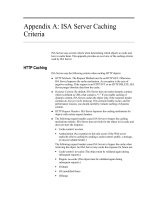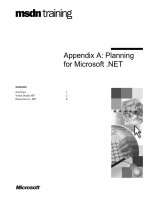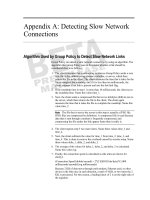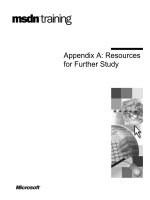Appendix a Unixbsd
Bạn đang xem bản rút gọn của tài liệu. Xem và tải ngay bản đầy đủ của tài liệu tại đây (673.4 KB, 64 trang )
Appendix A: UnixBSD
Appendix A: UnixBSD
A.2
Silberschatz, Galvin and Gagne ©2005
Operating System Concepts – 7
th
Edition, Feb 11, 2005
Module A: The FreeBSD System
Module A: The FreeBSD System
■
UNIX History
■
Design Principles
■
Programmer Interface
■
User Interface
■
Process Management
■
Memory Management
■
File System
■
I/O System
■
Interprocess Communication
A.3
Silberschatz, Galvin and Gagne ©2005
Operating System Concepts – 7
th
Edition, Feb 11, 2005
UNIX History
UNIX History
■
First developed in 1969 by Ken Thompson and Dennis Ritchie of the
Research Group at Bell Laboratories; incorporated features of other
operating systems, especially MULTICS
■
The third version was written in C, which was developed at Bell Labs
specifically to support UNIX
■
The most influential of the non-Bell Labs and non-AT&T UNIX
development groups — University of California at Berkeley (Berkeley
Software Distributions - BSD)
●
4BSD UNIX resulted from DARPA funding to develop a standard
UNIX system for government use
●
Developed for the VAX, 4.3BSD is one of the most influential
versions, and has been ported to many other platforms
■
Several standardization projects seek to consolidate the variant
flavors of UNIX leading to one programming interface to UNIX
A.4
Silberschatz, Galvin and Gagne ©2005
Operating System Concepts – 7
th
Edition, Feb 11, 2005
History of UNIX Versions
History of UNIX Versions
A.5
Silberschatz, Galvin and Gagne ©2005
Operating System Concepts – 7
th
Edition, Feb 11, 2005
Early Advantages of UNIX
Early Advantages of UNIX
■
Written in a high-level language
■
Distributed in source form
■
Provided powerful operating-system primitives on an inexpensive
platform
■
Small size, modular, clean design
A.6
Silberschatz, Galvin and Gagne ©2005
Operating System Concepts – 7
th
Edition, Feb 11, 2005
UNIX Design Principles
UNIX Design Principles
■
Designed to be a time-sharing system
■
Has a simple standard user interface (shell) that can be replaced
■
File system with multilevel tree-structured directories
■
Files are supported by the kernel as unstructured sequences of
bytes
■
Supports multiple processes; a process can easily create new
processes
■
High priority given to making system interactive, and providing
facilities for program development
A.7
Silberschatz, Galvin and Gagne ©2005
Operating System Concepts – 7
th
Edition, Feb 11, 2005
Programmer Interface
Programmer Interface
■
Kernel: everything below the system-call interface and above
the physical hardware
●
Provides file system, CPU scheduling, memory
management, and other OS functions through system calls
■
Systems programs: use the kernel-supported system calls to
provide useful functions, such as compilation and file
manipulation
Like most computer systems, UNIX consists of two separable parts:
A.8
Silberschatz, Galvin and Gagne ©2005
Operating System Concepts – 7
th
Edition, Feb 11, 2005
4.4BSD Layer Structure
4.4BSD Layer Structure
A.9
Silberschatz, Galvin and Gagne ©2005
Operating System Concepts – 7
th
Edition, Feb 11, 2005
System Calls
System Calls
■
System calls define the programmer interface to UNIX
■
The set of systems programs commonly available defines the user
interface
■
The programmer and user interface define the context that the
kernel must support
■
Roughly three categories of system calls in UNIX
●
File manipulation (same system calls also support device
manipulation)
●
Process control
●
Information manipulation
A.10
Silberschatz, Galvin and Gagne ©2005
Operating System Concepts – 7
th
Edition, Feb 11, 2005
File Manipulation
File Manipulation
■
A file is a sequence of bytes; the kernel does not impose a
structure on files
■
Files are organized in tree-structured directories
■
Directories are files that contain information on how to find other
files
■
Path name: identifies a file by specifying a path through the
directory structure to the file
●
Absolute path names start at root of file system
●
Relative path names start at the current directory
■
System calls for basic file manipulation: create, open, read,
write, close, unlink, trunc
A.11
Silberschatz, Galvin and Gagne ©2005
Operating System Concepts – 7
th
Edition, Feb 11, 2005
Typical UNIX Directory Structure
Typical UNIX Directory Structure
A.12
Silberschatz, Galvin and Gagne ©2005
Operating System Concepts – 7
th
Edition, Feb 11, 2005
Process Control
Process Control
■
A process is a program in execution
■
Processes are identified by their process identifier, an integer
■
Process control system calls
●
fork creates a new process
●
execve is used after a fork to replace on of the two processes’s
virtual memory space with a new program
●
exit terminates a process
●
A parent may wait for a child process to terminate; wait
provides the process id of a terminated child so that the parent
can tell which child terminated
●
wait3 allows the parent to collect performance statistics about
the child
■
A zombie process results when the parent of a defunct child process
exits before the terminated child
A.13
Silberschatz, Galvin and Gagne ©2005
Operating System Concepts – 7
th
Edition, Feb 11, 2005
Illustration of Process Control Calls
Illustration of Process Control Calls
A.14
Silberschatz, Galvin and Gagne ©2005
Operating System Concepts – 7
th
Edition, Feb 11, 2005
Process Control (Cont.)
Process Control (Cont.)
■
Processes communicate via pipes; queues of bytes between two
processes that are accessed by a file descriptor
■
All user processes are descendants of one original process, init
■
init forks a getty process: initializes terminal line parameters and
passes the user’s login name to login
●
login sets the numeric user identifier of the process to that of the
user
●
executes a shell which forks subprocesses for user commands
A.15
Silberschatz, Galvin and Gagne ©2005
Operating System Concepts – 7
th
Edition, Feb 11, 2005
Process Control (Cont.)
Process Control (Cont.)
■
setuid bit sets the effective user identifier of the process to the
user identifier of the owner of the file, and leaves the real user
identifier as it was
■
setuid scheme allows certain processes to have more than
ordinary privileges while still being executable by ordinary users
A.16
Silberschatz, Galvin and Gagne ©2005
Operating System Concepts – 7
th
Edition, Feb 11, 2005
Signals
Signals
■
Facility for handling exceptional conditions similar to software
interrupts
■
The interrupt signal, SIGINT, is used to stop a command before
that command completes (usually produced by ^C)
■
Signal use has expanded beyond dealing with exceptional events
●
Start and stop subprocesses on demand
●
SIGWINCH informs a process that the window in which output
is being displayed has changed size
●
Deliver urgent data from network connections
A.17
Silberschatz, Galvin and Gagne ©2005
Operating System Concepts – 7
th
Edition, Feb 11, 2005
Process Groups
Process Groups
■
Set of related processes that cooperate to accomplish a common
task
■
Only one process group may use a terminal device for I/O at any
time
●
The foreground job has the attention of the user on the terminal
●
Background jobs – nonattached jobs that perform their function
without user interaction
■
Access to the terminal is controlled by process group signals
A.18
Silberschatz, Galvin and Gagne ©2005
Operating System Concepts – 7
th
Edition, Feb 11, 2005
Process Groups (Cont.)
Process Groups (Cont.)
■
Each job inherits a controlling terminal from its parent
●
If the process group of the controlling terminal matches the
group of a process, that process is in the foreground
●
SIGTTIN or SIGTTOU freezes a background process that
attempts to perform I/O; if the user foregrounds that process,
SIGCONT indicates that the process can now perform I/O
●
SIGSTOP freezes a foreground process
A.19
Silberschatz, Galvin and Gagne ©2005
Operating System Concepts – 7
th
Edition, Feb 11, 2005
Information Manipulation
Information Manipulation
■
System calls to set and return an interval timer:
getitmer/setitmer
■
Calls to set and return the current time:
gettimeofday/settimeofday
■
Processes can ask for
●
their process identifier: getpid
●
their group identifier: getgid
●
the name of the machine on which they are executing:
gethostname
A.20
Silberschatz, Galvin and Gagne ©2005
Operating System Concepts – 7
th
Edition, Feb 11, 2005
Library Routines
Library Routines
■
The system-call interface to UNIX is supported and augmented by
a large collection of library routines
■
Header files provide the definition of complex data structures used
in system calls
■
Additional library support is provided for mathematical functions,
network access, data conversion, etc
A.21
Silberschatz, Galvin and Gagne ©2005
Operating System Concepts – 7
th
Edition, Feb 11, 2005
User Interface
User Interface
■
Programmers and users mainly deal with already existing systems
programs: the needed system calls are embedded within the
program and do not need to be obvious to the user
■
The most common systems programs are file or directory oriented
●
Directory: mkdir, rmdir, cd, pwd
●
File: ls, cp, mv, rm
■
Other programs relate to editors (e.g., emacs, vi) text formatters
(e.g., troff, TEX), and other activities
A.22
Silberschatz, Galvin and Gagne ©2005
Operating System Concepts – 7
th
Edition, Feb 11, 2005
Shells and Commands
Shells and Commands
■
Shell – the user process which executes programs (also called
command interpreter)
■
Called a shell, because it surrounds the kernel
■
The shell indicates its readiness to accept another command by
typing a prompt, and the user types a command on a single line
■
A typical command is an executable binary object file
■
The shell travels through the search path to find the command file,
which is then loaded and executed
■
The directories /bin and /usr/bin are almost always in the
search path
A.23
Silberschatz, Galvin and Gagne ©2005
Operating System Concepts – 7
th
Edition, Feb 11, 2005
Shells and Commands (Cont.)
Shells and Commands (Cont.)
■
Typical search path on a BSD system:
( ./home/prof/avi/bin /usr/local/bin /usr/ucb/bin /usr/bin )
■
The shell usually suspends its own execution until the command
completes
A.24
Silberschatz, Galvin and Gagne ©2005
Operating System Concepts – 7
th
Edition, Feb 11, 2005
Standard I/O
Standard I/O
■
Most processes expect three file descriptors to be open when they
start:
●
standard input – program can read what the user types
●
standard output – program can send output to user’s screen
●
standard error – error output
■
Most programs can also accept a file (rather than a terminal) for
standard input and standard output
■
The common shells have a simple syntax for changing what files
are open for the standard I/O streams of a process — I/O redirection
A.25
Silberschatz, Galvin and Gagne ©2005
Operating System Concepts – 7
th
Edition, Feb 11, 2005
Standard I/O Redirection
Standard I/O Redirection









